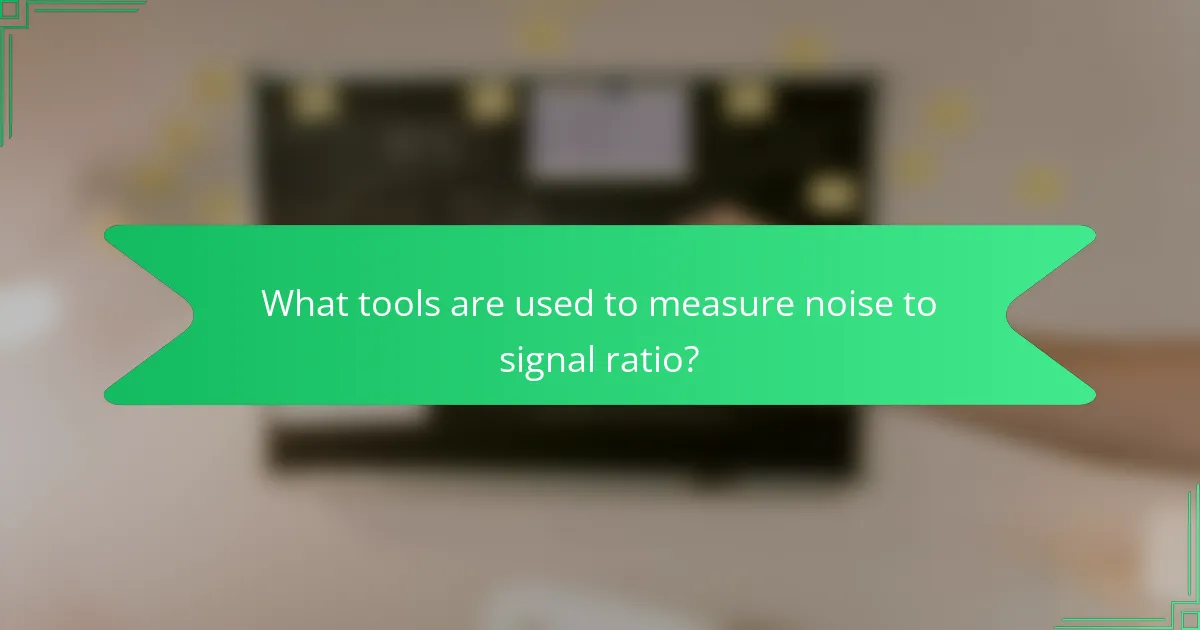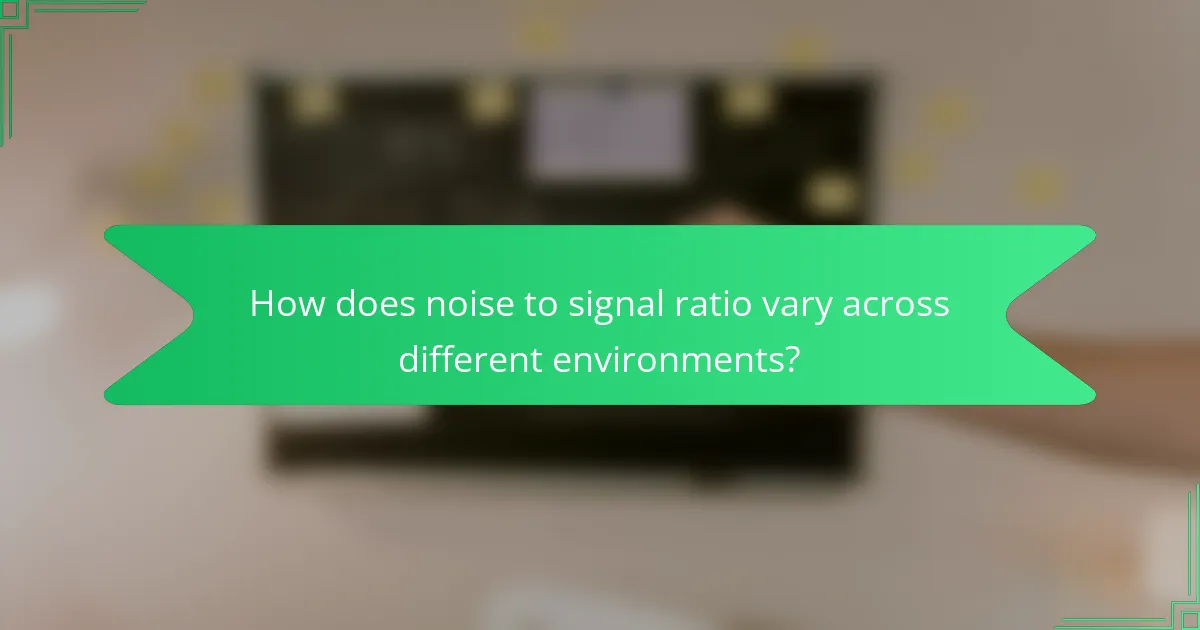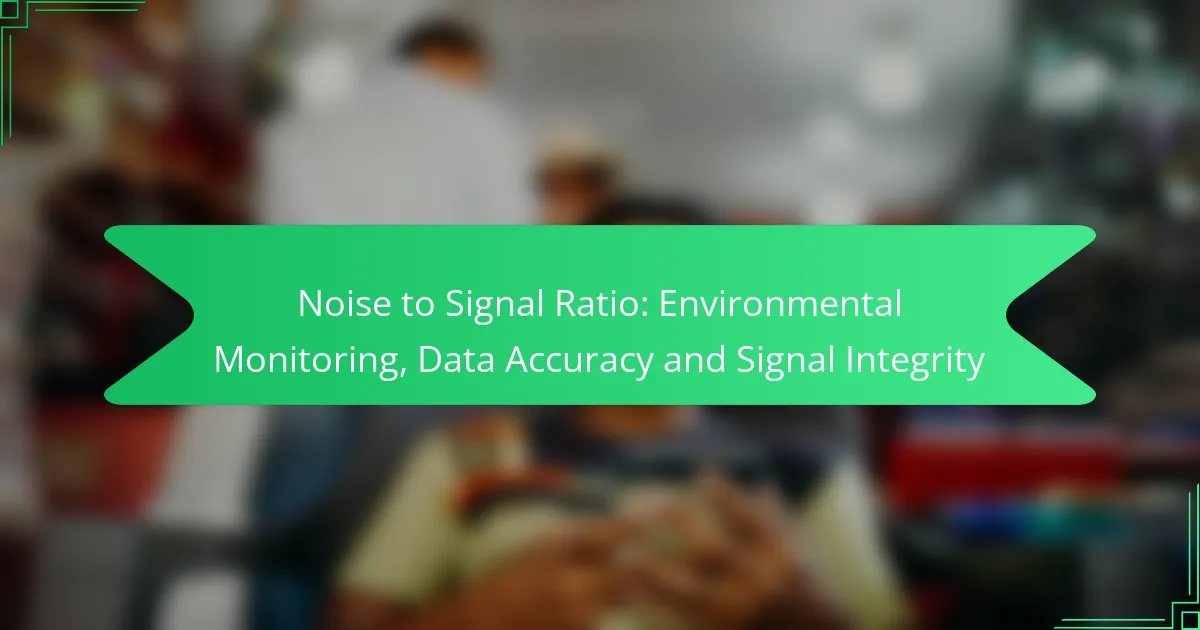The noise to signal ratio (NSR) is essential for effective environmental monitoring, as it determines the reliability and clarity of collected data. A higher NSR signifies a clearer distinction between meaningful signals and background noise, which enhances data quality and accuracy in assessing environmental conditions. Various tools, including sensors and signal processing software, are employed to measure NSR and ensure the integrity of environmental data.

How can noise to signal ratio improve environmental monitoring?
The noise to signal ratio (NSR) is crucial for enhancing environmental monitoring by ensuring that the data collected is reliable and meaningful. A higher NSR indicates clearer signals relative to background noise, leading to better data quality and more accurate assessments of environmental conditions.
Enhanced data accuracy
Improving the noise to signal ratio directly enhances data accuracy in environmental monitoring. When monitoring instruments have a low NSR, the data may be skewed by irrelevant background noise, leading to incorrect conclusions about environmental conditions. For example, in air quality monitoring, a high NSR allows for precise measurements of pollutants, ensuring that the data reflects true concentrations rather than fluctuations caused by noise.
To achieve enhanced data accuracy, it is essential to calibrate monitoring equipment regularly and use advanced filtering techniques. This can include digital signal processing methods that help isolate the signal from noise, ensuring that the data collected is as accurate as possible.
Better signal integrity
Better signal integrity is achieved when the noise to signal ratio is optimized, allowing for clearer and more reliable data transmission. In environmental monitoring, this means that the signals received from sensors are less likely to be distorted by external factors, such as electromagnetic interference or environmental conditions. For instance, in water quality monitoring, maintaining high signal integrity ensures that the readings of pH or turbidity are trustworthy.
To maintain signal integrity, it is advisable to use shielded cables and proper grounding techniques in sensor installations. Additionally, selecting the right sampling frequency can help reduce the impact of noise, further preserving the integrity of the data collected.
Improved decision-making
Improved decision-making in environmental management stems from the reliable data produced through a favorable noise to signal ratio. When data is accurate and signals are clear, stakeholders can make informed decisions regarding environmental policies, resource management, and public health interventions. For example, accurate air quality data can lead to timely actions to mitigate pollution levels, protecting community health.
To facilitate improved decision-making, organizations should invest in training personnel on data interpretation and analysis. Regularly reviewing and updating monitoring protocols based on NSR assessments can also help ensure that decisions are based on the best available data, ultimately leading to more effective environmental strategies.

What tools are used to measure noise to signal ratio?
Measuring noise to signal ratio (NSR) involves various tools that assess the clarity and integrity of environmental data. Key instruments include environmental sensors, data loggers, and signal processing software, each playing a crucial role in ensuring accurate readings.
Environmental sensors
Environmental sensors are devices designed to detect and measure specific environmental parameters such as temperature, humidity, and air quality. These sensors often include built-in noise filtering capabilities to enhance signal clarity and reduce interference from background noise.
When selecting environmental sensors, consider factors like sensitivity, calibration standards, and the specific environmental conditions they will operate in. For instance, a sensor used in urban areas may require higher noise resistance compared to one used in remote locations.
Data loggers
Data loggers are electronic devices that record data over time, often from multiple environmental sensors. They play a vital role in capturing the noise to signal ratio by storing data points that can later be analyzed for accuracy and reliability.
When using data loggers, ensure they have sufficient memory and battery life for your monitoring duration. It’s also important to choose loggers that can handle the expected data load without losing fidelity, particularly in noisy environments.
Signal processing software
Signal processing software analyzes the data collected from environmental sensors and data loggers to quantify the noise to signal ratio. This software applies algorithms that filter out noise, enhancing the quality of the signal for more accurate interpretation.
When selecting signal processing software, look for features such as real-time analysis, user-friendly interfaces, and compatibility with various data formats. Effective software can significantly improve data accuracy by identifying and mitigating noise interference in the collected data.

What factors affect noise to signal ratio in environmental data?
The noise to signal ratio (NSR) in environmental data is influenced by various factors including environmental conditions, sensor calibration, and data transmission methods. Understanding these factors can help improve data accuracy and ensure signal integrity during monitoring.
Environmental conditions
Environmental conditions such as temperature, humidity, and atmospheric pressure can significantly impact the noise to signal ratio. For instance, high humidity can introduce additional noise in sensor readings, while extreme temperatures may affect sensor performance and accuracy.
Consider using weather-resistant sensors in harsh environments to minimize the impact of these conditions. Regularly monitoring local weather patterns can also help in adjusting data collection strategies to ensure optimal signal integrity.
Sensor calibration
Proper sensor calibration is crucial for maintaining a low noise to signal ratio. Sensors that are not calibrated correctly can produce inaccurate readings, leading to increased noise levels in the data. Regular calibration against known standards is recommended to ensure that sensors provide reliable measurements.
Establish a routine calibration schedule based on the manufacturer’s guidelines and environmental conditions. This practice helps in identifying any drift in sensor performance and allows for timely adjustments to maintain data accuracy.
Data transmission methods
The method used to transmit data can also affect the noise to signal ratio. Wired connections typically offer lower noise levels compared to wireless methods, which can be susceptible to interference from other electronic devices or environmental factors.
When selecting a data transmission method, consider the trade-offs between convenience and reliability. For critical applications, using shielded cables or secure wireless protocols can help reduce noise and enhance signal integrity.

How does noise to signal ratio impact data accuracy?
The noise to signal ratio (NSR) significantly affects data accuracy by determining the clarity of the signal relative to background noise. A lower NSR indicates a clearer signal, which leads to more precise measurements and reliable data interpretation.
Reduces measurement errors
A high noise to signal ratio can introduce substantial measurement errors, making it difficult to discern actual environmental conditions. For instance, in air quality monitoring, excessive background noise can mask true pollutant levels, leading to inaccurate assessments.
To minimize measurement errors, ensure that monitoring equipment is calibrated correctly and positioned away from sources of interference. Regular maintenance and updates to the data collection methods can also help maintain a favorable NSR.
Increases reliability of results
Improving the noise to signal ratio enhances the reliability of results by ensuring that data reflects true environmental conditions rather than artifacts from noise. This is particularly crucial in fields such as climate science, where accurate data is essential for modeling and forecasting.
To increase the reliability of results, consider using advanced filtering techniques and data processing algorithms that can effectively separate noise from the signal. Additionally, employing multiple sensors in different locations can provide a more comprehensive view and help validate findings against potential noise interference.

What are the best practices for maintaining signal integrity?
Maintaining signal integrity is crucial for accurate environmental monitoring. Best practices include regular maintenance of sensors, proper installation techniques, and the use of shielding materials to minimize interference.
Regular sensor maintenance
Regular maintenance of sensors ensures they function correctly and provide reliable data. This includes cleaning sensors, checking for wear and tear, and recalibrating them according to manufacturer guidelines.
Establish a maintenance schedule based on the sensor type and environmental conditions. For instance, sensors exposed to harsh weather may require more frequent checks than those in controlled environments.
Proper installation techniques
Proper installation techniques are essential for signal integrity. Ensure that sensors are mounted securely and positioned to avoid physical obstructions that could interfere with data collection.
Follow installation guidelines specific to the sensor type, such as orientation and distance from potential noise sources. For example, placing sensors away from machinery or electrical lines can reduce interference.
Use of shielding materials
Using shielding materials can significantly enhance signal integrity by protecting sensors from electromagnetic interference. Common materials include metal enclosures and specialized cables designed to block noise.
When selecting shielding options, consider the specific environment and types of interference present. For example, in urban areas with high electromagnetic activity, more robust shielding may be necessary to ensure accurate readings.

How does noise to signal ratio vary across different environments?
The noise to signal ratio (NSR) can significantly differ between various environments, impacting data accuracy and signal integrity. In general, urban areas tend to have higher noise levels due to human activity, while rural settings usually exhibit lower noise levels, allowing for clearer signals.
Urban vs rural settings
In urban settings, the noise to signal ratio is often compromised by constant background noise from traffic, construction, and other human activities. This can lead to a higher NSR, making it challenging to capture accurate environmental data. For instance, sensors measuring air quality may struggle to differentiate between pollutants and noise from nearby vehicles.
Conversely, rural settings typically have a lower noise to signal ratio, resulting in clearer signals and more accurate data collection. The absence of industrial noise and fewer human disturbances allows environmental monitoring systems to function more effectively. For example, a weather station in a remote area can provide more reliable readings compared to one located in a bustling city.
When designing monitoring systems, consider the environment’s noise characteristics. In urban areas, it may be necessary to implement advanced filtering techniques or select more sensitive equipment to improve data accuracy. In rural settings, simpler systems may suffice, as the lower noise levels enhance signal clarity.










